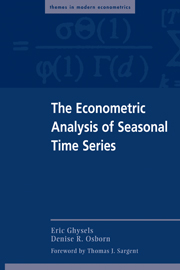Book contents
- Frontmatter
- Contents
- Foreword by Thomas J. Sargent
- Preface
- List of Symbols and Notations
- 1 Introduction to Seasonal Processes
- 2 Deterministic Seasonality
- 3 Seasonal Unit Root Processes
- 4 Seasonal Adjustment Programs
- 5 Estimation and Hypothesis Testing with Unfiltered and Filtered Data
- 6 Periodic Processes
- 7 Some Nonlinear Seasonal Models
- Epilogue
- Bibliography
- Subject Index
- Author Index
Epilogue
Published online by Cambridge University Press: 05 June 2012
- Frontmatter
- Contents
- Foreword by Thomas J. Sargent
- Preface
- List of Symbols and Notations
- 1 Introduction to Seasonal Processes
- 2 Deterministic Seasonality
- 3 Seasonal Unit Root Processes
- 4 Seasonal Adjustment Programs
- 5 Estimation and Hypothesis Testing with Unfiltered and Filtered Data
- 6 Periodic Processes
- 7 Some Nonlinear Seasonal Models
- Epilogue
- Bibliography
- Subject Index
- Author Index
Summary
The subject of seasonality has evolved a great deal over the past decade. As noted in the Preface, several books and special journal issues have been devoted to the subject in recent years. This monograph has attempted to review the principal theoretical developments in the field that have taken place since the work of Hy lleberg (1986), which provided a comprehensive treatment of seasonality and econometric modeling up until the mid-1980s. It is acknowledged that empirical studies have been largely neglected in this monograph. This is not because they are unimportant. Rather it is because there are important complications to dealing with real data and a superficial treatment of these issues would not do them justice. We hope that other authors will take up the challenge of providing a comprehensive empirical treatment of seasonality in economic and financial time series.
The 1980s and 1990s have seen giant leaps forward made in asymptotic distribution theory for linear nonstationary stochastic processes. Although attention has obviously focused on zero-frequency behavior and associated tests for unit root nonstationarity, this has also led to windfall advances for seasonal time processes with possible seasonal unit roots. There is now a large degree of consensus about zero-frequency unit root behavior. Almost all data are first differenced without any further discussion, since the unit root hypothesis is taken for granted. There are nevertheless some serious questions about the adequacy of the zero-frequency unit root representation lingering in the back of any sophisticated time series econometrician's mind.
- Type
- Chapter
- Information
- The Econometric Analysis of Seasonal Time Series , pp. 203 - 206Publisher: Cambridge University PressPrint publication year: 2001

